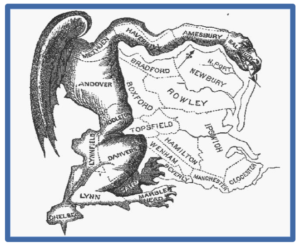
What Is It?

Gerrymandering is the drawing of political districts for partisan advantage. It enables the party in charge to draw electoral maps that ensure they will win a larger share of seats than their share of the votes.
Gerrymandering is as old as our national government: Patrick Henry gerrymandered James Madison’s district in 1789, trying (unsuccessfully) to engineer his defeat in the very first Congressional election. The term “gerrymander” was coined in 1812 by a journalist angered at the bizarre districts drawn by Massachusetts Governor Elbridge Gerry to ensure his party a majority in the state legislature. He thought one district resembled a salamander: the Gerry-mander was born! Gerry later served as Madison’s vice president.
How Does Gerrymandering Work?
When the party in power draws the electoral maps, they are naturally tempted to “gerrymander” electoral districts to secure a continued majority for themselves and safe seats for their members. Both parties do it.
Gerrymandering can be done along partisan or racial/ethnic lines, or both. Three main techniques are used and often combined:
- Packing: drawing districts to pack as many of the opposing party’s supporters as possible into a small number of districts, so that the voters for party in charge have at least a slim majority in a much larger share of the districts. Packing works best where there is geographic concentration of the opposing party’s voters, for example, where some areas have high concentrations of minority voters who generally support a particular party.
- Cracking: breaking up concentrations of the opposition party’s supporters to spread them across as many districts as possible. The aim is to gives the party in charge majority in as many districts as possible.
- Incumbents and challengers: drawing maps that separate incumbents in the opposition party from their established base to put them into a district less favorable to their candidacy, that prevent a promising challenger from running against the favored incumbent or candidate of the party in charge, or that “double-bunk” two of the opposition party’s incumbents into a single district, ensuring that at least one will be eliminated.
Here's an example.